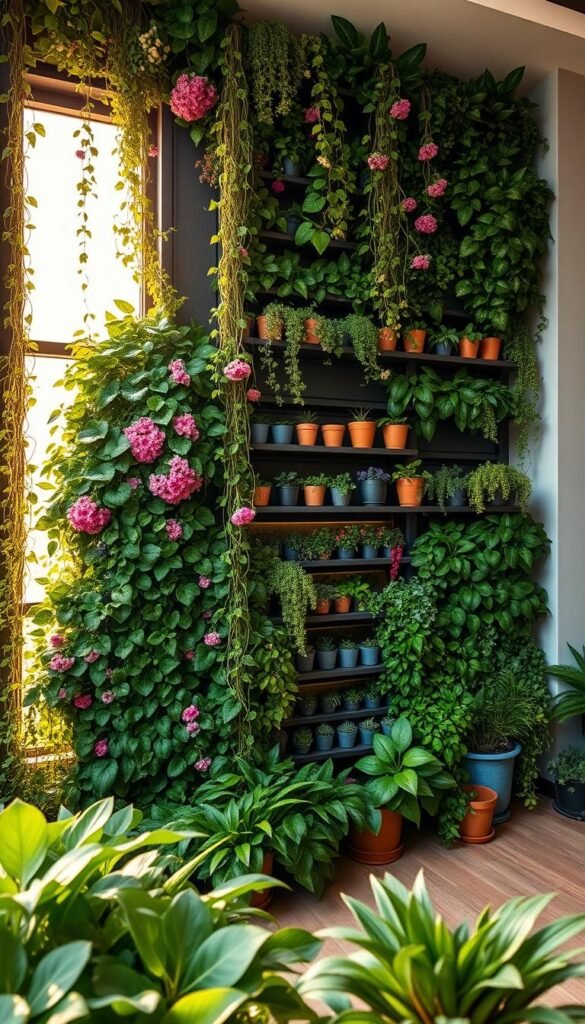Imagine turning empty surfaces into vibrant ecosystems that refresh your space and mood. Vertical greenery isn’t just a trend—it’s a smart way to add personality and function to cramped patios, bland walls, or even indoor corners. Studies show these installations do more than look pretty: they purify air, reduce stress, and even boost immunity by exposing you to healthier environments daily.
Adam Baron of Folia Gardens in Brooklyn notes how these setups “soften architectural features while adding shade and privacy” in cities like New York. Whether you’re working with a balcony or a blank living room wall, there’s potential to grow herbs, flowers, or leafy vines upward. Recent trials reveal that certain plants, like basil in upcycled containers, produce 20% more aromatic oils than store-bought versions—proof that smart design impacts results.
No yard? No problem. Systems like modular towers or hanging planters let you maximize small spaces without sacrificing style. They’re perfect for crafting privacy screens, accent walls, or even edible gardens in tight urban settings. Plus, research confirms that greenery-rich areas make 68% of people feel calmer—a win for mental well-being.
Ready to reimagine your walls? Let’s explore how to blend practicality with artistry, transforming overlooked spots into lively showcases.
Vertical Gardening: Transform Your Outdoor Space
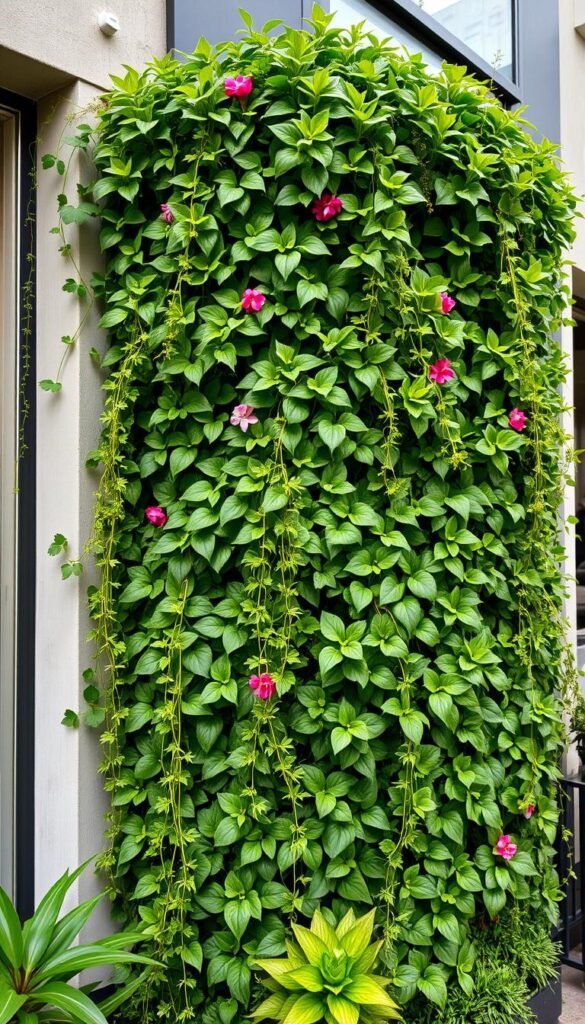
Elevate your surroundings—literally—by rethinking how you use walls, fences, and railings. This approach isn’t just about saving square footage. It’s a lifestyle upgrade that merges beauty with purpose, perfect for urban dwellers or anyone craving a nature-infused retreat.
Health and Well-Being Benefits
Living walls act as natural air filters, removing pollutants while releasing oxygen. Studies show they reduce stress hormones by up to 15%—which explains why wellness centers love them. Todd Haiman of Todd Haiman Landscape Design puts it best:
“These installations defy gravity while sparking creativity. They’re bridges between modern design and ancient growing traditions.”
You’ll notice fewer seasonal allergies too. Improved airflow around vertically grown plants minimizes mold and mildew buildup. Plus, tending to greenery offers mindfulness benefits similar to yoga or meditation.
Maximizing Your Growing Space
Nick Runkle from Stanly Ranch highlights efficiency:
“You can grow three times more herbs in vertical setups than in traditional beds.”
Even fire escapes or narrow balconies become productive zones. Modular systems let you stack strawberries, lettuces, or flowers without overcrowding.
Smart designs also reduce pest issues. Elevating plants creates natural barriers against ground insects. Pair this with unique ways to decorate your outdoor, and you’ll turn functional setups into conversation starters. Just ensure proper sunlight exposure—south-facing walls often work best.
Creative Garden Wall Ideas for Vertical Plant Displays
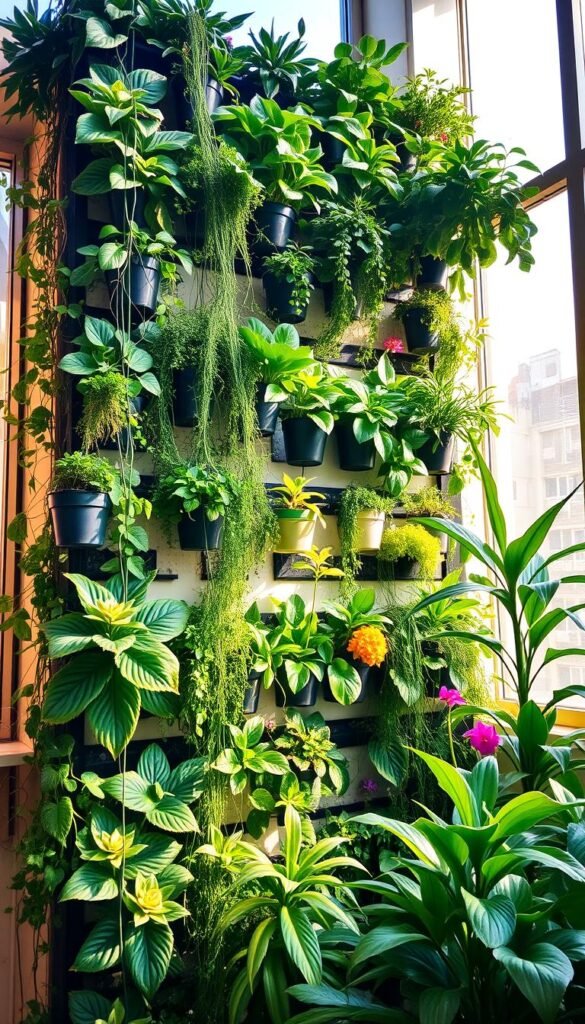
Turn overlooked spaces into lush canvases that breathe life into your home. Vertical setups let you merge artistry with utility, whether you’re crafting a kitchen herb wall or a cascading floral masterpiece. Texture contrast is key—pair feathery ferns with spiky succulents for visual drama.
“Treat your wall like a living painting. Layer trailing vines at the top, bold foliage in the middle, and compact blooms near the base.”
This approach creates depth while ensuring all plants get adequate light.
Consider these three systems for different needs:
| System Type | Best For | Plant Capacity |
|---|---|---|
| Pocket Planters | Herbs & Small Flowers | 15-20 plants |
| Modular Grids | Leafy Greens & Ferns | 30-50 plants |
| Repurposed Pallets | Trailing Vines | 10-15 plants |
For tight areas, space-saving vertical racks let you rotate plants seasonally. Mix edible and ornamental species—think purple basil beside pansies—to delight the senses. A Chicago café boosted customer dwell time by 40% after installing such a feature wall.
Balance bold statement pieces with subtle greenery clusters. Use odd-numbered groupings (3s or 5s) for natural rhythm. Your living wall becomes more than decor—it’s a reflection of your unique perspective on growth.
Planning Your Vertical Garden Design
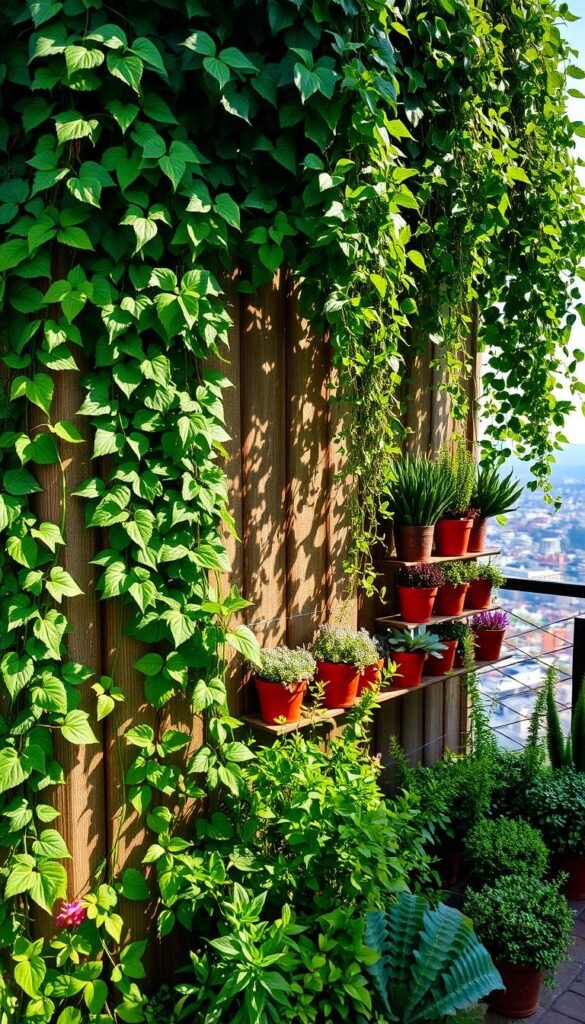
Designing a thriving vertical setup starts with smart planning. Before picking plants or materials, assess your location’s unique conditions. This ensures your green feature stays healthy while protecting your home’s surfaces.
Assessing Your Available Space
Begin by tracking sunlight patterns across your wall or balcony. South-facing spots often get 6+ hours of direct light—ideal for herbs and veggies. North-facing areas work better for shade-loving ferns.
Check wind exposure too. High-rise balconies might need windbreaks like lattice panels. Adam Baron of Folia Gardens advises:
“Test your structure’s weight limit with sandbags before installing. Waterlogged soil adds 40% more weight than dry.”
Selecting the Right Materials
Choose frames that match your plants’ needs. Metal grids suit climbing beans, while pocket planters work for strawberries. Baron recommends galvanized steel for humid climates—it resists rust 3x longer than untreated iron.
| Material Type | Best Use Cases | Durability |
|---|---|---|
| Galvanized Steel | Humid climates | 15-20 years |
| Cedar Wood | Decorative displays | 7-10 years |
| Recycled Plastic | Budget projects | 5-8 years |
Include drainage layers like gravel or perforated liners to prevent water damage. Modular systems let you expand your garden as skills grow. Start small—even 4 sq. ft. can hold 18 plants!
Incorporating Hanging Planters and Potted Plants
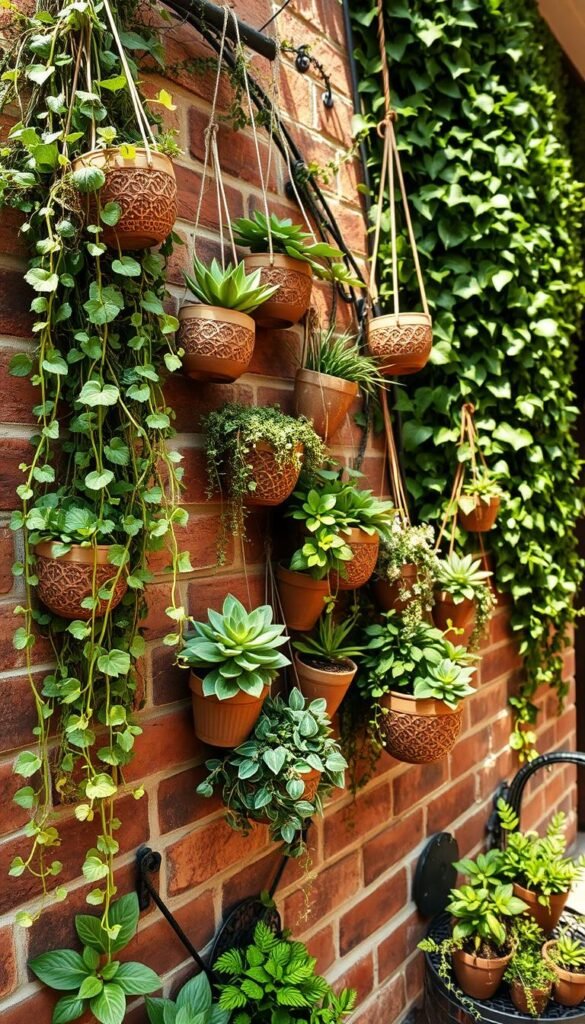
Elevate your decor game with dynamic arrangements that defy traditional layouts. Suspended greenery adds movement to spaces while anchored pots create structured focal points. Both options let you experiment with height and density without permanent installations.
Hanging vs. Mounted Options
Hanging planters offer flexibility—swap positions weekly to match sunlight needs or refresh your visual theme. Retailers like Target and Home Depot carry modular systems where individual pockets merge into lush tapestries as plants mature. For renters, removable adhesive hooks provide damage-free mounting.
Mounted planters work best for cohesive designs. Attach cedar boxes or metal grids directly to walls for cascading ivy or herbs. Over time, these grow into seamless green partitions. Just ensure proper drainage—line containers with coconut coir to prevent water stains.
DIY Ideas for Stylish Displays
Transform thrift finds into conversation starters. Drill drainage holes in vintage colanders for strawberry planters, or paint mismatched tin cans as quirky potted plants holders. Use macramé hangers to showcase air plants near sunny windows.
Group hanging elements at varying levels using adjustable chains. Odd-number clusters (3 or 5) create rhythm. For shaded porches, mix ferns in woven baskets with mounted succulents. This layered approach maximizes texture while simplifying care routines.
Affordable hardware store hooks let you rearrange displays seasonally. Start with one statement piece—like a geometric wall planter—then expand as your confidence grows. Your space becomes a living gallery that evolves with your creativity.
Living Walls: Bringing Color and Texture
Transform blank spaces into living art that delights the senses. Whether you’re dressing up a sunlit wall or brightening a dim corner, strategic plant choices turn functional setups into focal points. Start by balancing visual appeal with practical care needs.
Choosing the Perfect Plants
Match species to your environment. For indoor installations, combine drought-tolerant succulents with velvety moss—they thrive with minimal watering. Hanging displays shine with trailing varieties like pothos or philodendron, which adapt well to container life.
Shelves and ledges become mini jungles with:
- Monstera’s split leaves for tropical drama
- Peace lilies that bloom in low light
- Aloe vera for sculptural shapes
Outdoor spaces benefit from English ivy’s rapid growth or Boston fern’s feathery fronds. Always check sunlight levels—bright areas suit flowering species, while shade-loving picks prevent bare patches.
Watering and Maintenance Tips
Consistency prevents stress. Vertical setups dry faster than pots, so install drip irrigation kits from brands like DripWorks. These systems deliver moisture evenly while saving time—perfect for urban balconies with limited access.
Follow this care checklist:
- Test soil moisture daily with your finger
- Trim yellowing leaves weekly
- Rotate planters monthly for even growth
Mix textures and growth speeds for dynamic displays. Pair spiky aloe with flowing ivy, or cluster red anthurium blooms among green foliage. Your living feature evolves with each season, offering fresh perspectives.
Vertical Veggie Gardens: Growing More in Less Space
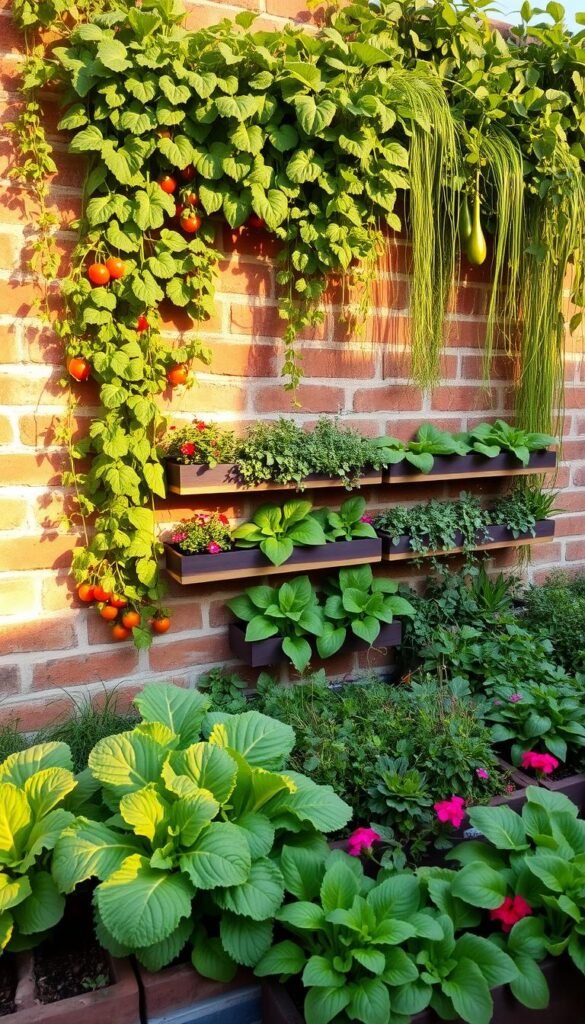
Who says you need a sprawling backyard to grow fresh veggies? Vertical systems let you harvest tomatoes from your balcony or snip herbs in your kitchen year-round. Climbing varieties like peas and cucumbers naturally reach upward, while hydroponic towers bring soil-free farming indoors.
Climbing Vegetables and Herbs
Nick Runkle, urban farming expert, advises:
“Pole beans and indeterminate tomatoes can triple your yield compared to bush varieties. Just ensure your trellises hold 25+ pounds when wet.”
Heavy producers need robust supports. Metal A-frames or reinforced wooden lattices prevent collapses during peak growth.
| Vegetable Type | Support Needs | Yield Per Plant |
|---|---|---|
| Tomatoes | Steel cage or stake | 10-15 lbs |
| Cucumbers | Nylon netting | 5-8 lbs |
| Pole Beans | Bamboo teepee | 1-2 lbs |
Innovative Indoor Hydroponic Towers
Grow basil in January or jalapeños during snowstorms. These water-efficient systems use 90% less space than pots. Runkle adds:
“Lettuce matures 30% faster under LED lights compared to outdoor beds.”
Popular setups include:
- Stackable herb gardens for windowsills
- Six-foot towers with 36 planting sites
- Self-watering models with pH monitors
Pair peppermint with parsley for aromatic displays that double as pantry staples. You’ll enjoy restaurant-quality ingredients without stepping outside.
DIY Vertical Planter Projects
Unleash your inner designer by transforming discarded objects into thriving plant displays. With a little ingenuity, everyday items become functional art that grows alongside your skills. Let’s explore how to craft eye-catching setups without breaking the bank.
Repurposing Everyday Items
Sam Niemann, urban gardening advocate, proves creativity trumps cost:
“An old picture frame becomes a living canvas when you attach a wooden box to its back—perfect for trailing succulents or herbs.”
Hunt thrift stores for colanders, teapots, or vinyl records that can hold soil. Mount rain gutters horizontally on fences for instant herb channels—their shallow depth suits basil and thyme perfectly.
Budget-Friendly Creative Ideas
Spray-painted tin cans add pops of color while keeping costs under $1 per planter. Stack terracotta pots on rebar rods threaded through drainage holes—this tower design triples growing space on patios. Wooden pallets? Flip them vertically, line compartments with landscape fabric, and fill with strawberries or marigolds.
For climbing support, integrate DIY trellises using bamboo poles or wire grids. Test each structure’s weight capacity—wet soil adds heft. Your upcycled creations prove sustainability and style coexist beautifully.
Utilizing Vines and Climbing Plants
Climbing plants offer more than just beauty—they’re problem-solvers for awkward spaces. Whether you’re dressing up a bare fence or softening a concrete balcony corner, vines add texture while saving floor space. They thrive in tight spots where traditional pots won’t fit, making them ideal for urban settings.
Trellis, Cable, and Mesh Options
Choose supports that match your style and plant needs. Lightweight mesh panels work well for delicate jasmine or peas, while sturdy metal trellises handle heavy growers like ivy. A study by Urban Greening found that copper frames extend vine lifespan by 30% compared to untreated wood.
For renters or those in city apartments, tension cables offer removable solutions. Attach them between walls or railings to guide climbing philodendrons without drilling. Remember: wet soil adds weight, so secure structures properly.
Bamboo grids provide rustic charm for beans, while acrylic sheets create modern backdrops for flowering vines. Mix materials to turn functional supports into artful accents.

